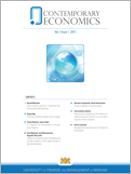Quantitative Easing: New Normal or Emergency Measure?
Quantitative Easing: New Normal or Emergency Measure?
Author(s): Piotr BartkiewiczSubject(s): International relations/trade, Financial Markets, Public Finances, Fiscal Politics / Budgeting
Published by: Akademia Ekonomiczno-Humanistyczna w Warszawie
Keywords: monetary policy; quantitative easing; central banks; global financial crisis;
Summary/Abstract: This article explores the economic justification of the use of unconventional monetary policy instruments such as asset purchase programmes (known as quantitative easing, QE) with the aim of assessing the nature of QE in the context of future monetary policy in Poland. Since 2008, numerous asset purchase programmes have been launched by central banks in major developed economies to raise economic growth and inflation in the aftermath of the Global Financial Crisis. These programmes can be seen either as part of broader, longer trends (demographic, socioeconomic) or as an emergency measure (i.e. a response to unique circumstances). The former hypothesis calls on central banks to treat unconventional monetary policy instruments as a necessary part of their toolbox, while the latter implies that QE is unlikely to be used again in the future. Drawing from a wide set of macroeconomic data and a proprietary literature review, I describe the macroeconomic context for unconventional monetary policy, present arguments for both paradigms and their implications. I conclude that recent developments favor the former hypothesis and that this debate will most likely be settled within several years and can be informed by business cycle developments in major developed economies.
Journal: Contemporary Economics
- Issue Year: 14/2020
- Issue No: 3
- Page Range: 306-319
- Page Count: 14
- Language: English

